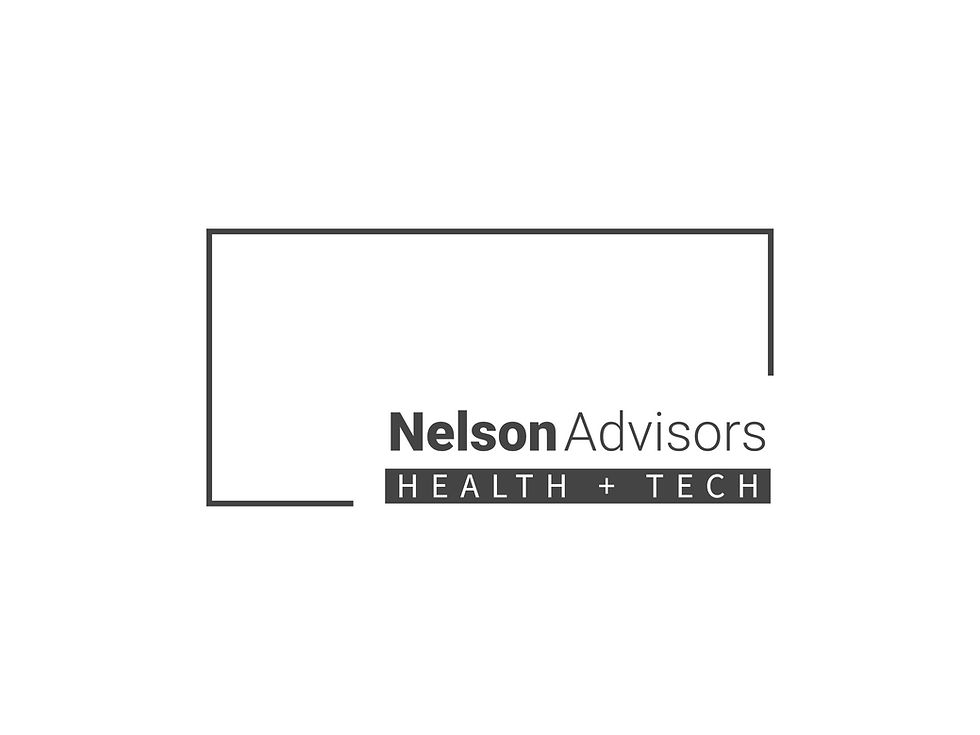Average Multiples in HealthTech M&A deals: April 2024
- Lloyd Price
- Apr 21, 2024
- 10 min read
Updated: Jul 25

Exec Summary
The average multiples in HealthTech M&A deals in 2024 have slightly increased compared to 2023, reflecting a more optimistic but still cautious approach by investors in the face of broader socio economic and political uncertainty.
As of April 2024, the average enterprise value (EV) to sales multiple is 4.8x, up from 4.5x in November 2023 and the average EV to EBITDA multiple range is 10x to 12.5x .
Here's a breakdown of average multiples for different types of HealthTech companies in 2023:
Telehealth companies: 5.5x to 4.7x
Wellness companies: 4.0x to 3.2x
Drug discovery companies: 7.0x to 5.5x
Medical device companies: 5.0x to 4.0x
Healthcare IT companies: 3.5x to 2.5x
It's important to note that these are just averages, the actual multiples for individual deals can vary significantly depending on the specific company, its growth prospects, and the competitive landscape.
Several factors have contributed to the decline in HealthTech valuations in the first 100 days of 2024:
Broader Market Slowdown: The overall stock market and technology sector have seen a correction in 2023, which can lead to a more cautious approach from investors and acquirers in HealthTech as well.
Rising Interest Rates: The increase in interest rates can make debt financing, a common tool for M&A deals, more expensive. This can cool down deal activity and potentially lower valuations.
Investor Scrutiny: Investors might be placing more emphasis on profitability and sustainable growth compared to the rapid-growth focus of the past few years. Companies with weaker financials or less clear paths to profitability might see lower valuations.
Maturing Sector: The HealthTech sector has seen significant growth and investment in recent years. As the sector matures, valuations might become more grounded in fundamentals rather than future potential alone.
The softening of Healthtech M&A multiples is likely to continue in the near term, but the long-term outlook for the sector remains positive. Companies that can demonstrate clear paths to profitability and address regulatory concerns are likely to be the most attractive to investors and acquirers.
It's important to note that the picture is not entirely negative:
Continued interest: There is still significant investor interest in the Healthtech sector, driven by long-term trends such as digitalisation, aging populations, and the increasing importance of personalised medicine.
Strategic deals: M&A activity is likely to continue, but with a focus on strategic deals that bring together complementary technologies or expertise.
Public market impact: The softening in M&A multiples could also put pressure on valuations in the public markets for Healthtech companies.
Nelson Advisors > Healthcare Technology M&A
Nelson Advisors specialise in mergers, acquisitions and partnerships for Digital Health, HealthTech, Health IT, Consumer HealthTech, Healthcare Cybersecurity, Healthcare AI companies based in the UK, Europe and North America. www.nelsonadvisors.co.uk
Nelson Advisors regularly publish Healthcare Technology thought leadership articles covering market insights, trends, analysis & predictions @ https://www.healthcare.digital
We share our views on the latest Healthcare Technology mergers, acquisitions and partnerships with insights, analysis and predictions in our LinkedIn Newsletter every week, subscribe today! https://lnkd.in/e5hTp_xb
Founders for Founders > We pride ourselves on our DNA as ‘HealthTech entrepreneurs advising HealthTech entrepreneurs.’ Nelson Advisors partner with entrepreneurs, boards and investors to maximise shareholder value and investment returns. www.nelsonadvisors.co.uk
#NelsonAdvisors #HealthTech #DigitalHealth #HealthIT #Cybersecurity #HealthcareAI #ConsumerHealthTech #Mergers #Acquisitions #Partnerships #Growth #Strategy #NHS #UK #Europe #USA #VentureCapital #PrivateEquity #Founders #BuySide #SellSide#Divestitures #Corporate #Portfolio #Optimisation #SeriesA #SeriesB #Founders #SellSide #TechAssets #Fundraising#BuildBuyPartner #GoToMarket #PharmaTech #BioTech #Genomics #MedTech
Nelson Advisors LLP
Hale House, 76-78 Portland Place, Marylebone, London, W1B 1NT
Meet Us @ HealthTech events
Digital Health Rewired > 18-19th March 2025 > Birmingham, UK
NHS ConfedExpo > 11-12th June 2025 > Manchester, UK
HLTH Europe > 16-19th June 2025, Amsterdam, Netherlands
Barclays Health Elevate > 25th June 2025, London, UK
HIMSS AI in Healthcare > 10-11th July 2025, New York, USA
Bits & Pretzels > 29th Sept-1st Oct 2025, Munich, Germany
World Health Summit 2025 > October 12-14th 2025, Berlin, Germany
HealthInvestor Healthcare Summit > October 16th 2025, London, UK
HLTH USA 2025 > October 18th-22nd 2025, Las Vegas, USA
Web Summit 2025 > 10th-13th November 2025, Lisbon, Portugal
MEDICA 2025 > November 11-14th 2025, Düsseldorf, Germany
Venture Capital World Summit > 2nd December 2025, Toronto, Canada

HealthTech M&A transactions
HealthTech M&A transactions can vary significantly in terms of size, nature, and market conditions. The multiples, or valuation metrics, used in these transactions are typically based on factors such as revenue, earnings, or users/subscribers, and can differ based on the company's stage of development, growth prospects, market position, and other relevant factors.
Revenue Multiples: One commonly used metric is the revenue multiple, which measures the value of a company relative to its revenue. In HealthTech, revenue multiples can range widely depending on factors such as the company's growth rate, profitability, and competitive landscape. In the past, revenue multiples for HealthTech companies have ranged from 1x to 10x or more, with some highly valued companies commanding even higher multiples.
Earnings Multiples: Another metric used in M&A transactions is the earnings multiple, which compares a company's valuation to its earnings (e.g., EBITDA - Earnings Before Interest, Taxes, Depreciation, and Amortization). Earnings multiples for HealthTech companies can vary based on factors such as profitability, growth potential, and industry trends. The range of earnings multiples in the HealthTech sector has historically been broad, spanning from single-digit multiples to higher double-digit or triple-digit multiples for high-growth, high-margin companies.
User/Subscriber Multiples: In some cases, HealthTech companies with user-focused business models, such as telemedicine or digital health platforms, may be valued based on the number of users or subscribers they have acquired. Valuations based on these metrics can vary significantly depending on the size of the user base, user engagement, revenue per user, and other factors. While there isn't a fixed average multiple for user/subscriber-based valuations in HealthTech M&A, they can range from a few dollars per user to several hundred or even thousands of dollars per user, depending on the company's unique circumstances.

Softening of the market
Healthtech M&A multiples are softening overall in 2024 compared to 2023, driven by a confluence of macroeconomic, market-specific, and company-level factors.
Macroeconomic headwinds:
Rising interest rates and inflation are increasing the cost of capital and making future cash flows less predictable, dampening investor enthusiasm.
Recessionary fears are pushing investors towards safer bets and reducing their appetite for riskier Healthtech plays.
Healthtech market dynamics:
Maturation and saturation: Some segments might be nearing saturation, leading to decreased investor interest and lower valuations.
Shifting investor focus: Investors are prioritising established, profitable companies with proven track records, leaving less room for unproven startups.
Regulatory landscape:
Increased scrutiny: Heightened regulatory scrutiny creates uncertainty and deters investors from certain segments.
Evolving regulations: Continuous regulatory changes add complexity and compliance costs, making acquisitions less attractive.
Internal company factors:
Unproven business models: Companies lacking clear paths to profitability are less attractive to investors seeking stable returns.
Execution challenges: Companies facing execution issues like slow adoption or product delays see their valuations suffer.
Impact:
Reduced access to capital for some Healthtech companies.
Potential consolidation as larger players acquire smaller ones.
Increased pressure on Healthtech companies to demonstrate profitability and viability.

Key trends driving strategic healthtech acquisitions:
Here are some of the specific trends that are driving strategic healthtech acquisitions in today's market:
The increasing demand for digital health solutions: The aging population and the growing prevalence of chronic diseases are driving the demand for digital health solutions. This is creating opportunities for healthtech companies that offer products and services that can improve the quality of care and reduce costs.
The rise of artificial intelligence and machine learning: Artificial intelligence and machine learning are rapidly transforming the healthcare industry. These technologies are being used to develop new diagnostic tools, improve the efficiency of clinical workflows, and personalise treatment plans.
The growing focus on preventive care: The healthcare industry is shifting its focus from reactive care to preventive care. This is creating opportunities for healthtech companies that offer products and services that can help people stay healthy.
The increasing regulatory scrutiny: The healthcare industry is heavily regulated. This can make it difficult for healthtech companies to bring new products and services to market. However, it also creates opportunities for companies that can help healthcare organizations comply with regulations.
Overall, the strategic healthtech acquisition market is very active.
There are a number of factors driving this activity, including the increasing demand for digital health solutions, the rise of artificial intelligence and machine learning, the growing focus on preventive care, and the increasing regulatory scrutiny.

Key priorities for strategic healthtech acquirers:
The key priorities for strategic healthtech acquirers are:
Growth: Strategic acquirers are looking for companies that can help them grow their businesses. This could mean acquiring companies that operate in new markets, offer new products or services, or have a strong customer base.
Innovation: Strategic acquirers are also looking for companies that are innovative and can help them stay ahead of the competition. This could mean acquiring companies that are developing new technologies or have a strong track record of innovation.
Market share: Strategic acquirers may also be looking to acquire companies that will give them a larger market share. This could be in a specific market or in the overall healthtech market.
Competitive advantage: Strategic acquirers may also be looking to acquire companies that will give them a competitive advantage. This could be through access to new technologies, markets, or customers.
Revenue: Strategic acquirers may also be looking to acquire companies that will generate additional revenue. This could be through the sale of products or services, or through the expansion of the acquirer's existing business.
Profitability: Strategic acquirers may also be looking to acquire companies that are profitable. This could mean acquiring companies that have a strong track record of profitability or that have the potential to become profitable in the future.
Exit strategy: Strategic acquirers may also have an exit strategy in mind, such as taking the acquired company public or selling it to another company. This will affect the type of company they are looking to acquire and the price they are willing to pay.

The Future of HealthTech M&A
The future of HealthTech M&A is likely to be shaped by several key trends:
Rising Healthcare Costs and Pressure on Payers: Healthcare costs are rising at an alarming rate, putting pressure on payers, such as insurance companies and government programs. This is driving a demand for M&A activity that can help to improve efficiency and reduce costs.
Technological Innovation: The healthcare industry is undergoing a period of rapid technological innovation, with the emergence of new technologies such as artificial intelligence, robotics, and genomics. This is creating opportunities for M&A activity that can help companies to acquire new technologies and capabilities.
Changing Consumer Expectations: Consumers are becoming more informed and demanding about their healthcare experiences. They are increasingly looking for personalized, convenient, and affordable care. This is driving a demand for M&A activity that can help companies to meet these evolving consumer expectations.
Global Expansion: The healthcare industry is becoming increasingly globalized, with companies expanding into new markets to reach a wider patient base. This is creating opportunities for M&A activity that can help companies to enter new markets and gain access to new technologies and talent.
Regulatory Landscape: The regulatory landscape for healthcare M&A is complex and constantly evolving. Companies need to carefully consider the regulatory implications of any acquisition before proceeding.
Here are some specific examples of how these trends are likely to shape the future of HealthTech M&A:
We will see more deals between payers and providers: Payers are looking to acquire providers to gain more control over the healthcare system and improve their ability to manage costs. Providers are looking to acquire payers to gain access to new patient populations and improve their financial stability.
We will see more deals between technology companies and healthcare companies: Technology companies are looking to acquire healthcare companies to gain access to new markets and new data sources. Healthcare companies are looking to acquire technology companies to improve their ability to collect, analyse, and use data to improve patient care.
We will see more deals between healthcare companies and consumer-facing companies: Healthcare companies are looking to acquire consumer-facing companies to improve their ability to reach and engage with patients. Consumer-facing companies are looking to acquire healthcare companies to gain access to new data and insights into the healthcare industry.
Overall, the future of HealthTech M&A is bright. The industry is undergoing a period of rapid change and innovation, and M&A is playing a key role in driving this transformation. As these trends continue to develop, we can expect to see even more M&A activity in the healthcare sector in the years to come.
Nelson Advisors > Healthcare Technology M&A
Nelson Advisors specialise in mergers, acquisitions and partnerships for Digital Health, HealthTech, Health IT, Consumer HealthTech, Healthcare Cybersecurity, Healthcare AI companies based in the UK, Europe and North America. www.nelsonadvisors.co.uk
Nelson Advisors regularly publish Healthcare Technology thought leadership articles covering market insights, trends, analysis & predictions @ https://www.healthcare.digital
We share our views on the latest Healthcare Technology mergers, acquisitions and partnerships with insights, analysis and predictions in our LinkedIn Newsletter every week, subscribe today! https://lnkd.in/e5hTp_xb
Founders for Founders > We pride ourselves on our DNA as ‘HealthTech entrepreneurs advising HealthTech entrepreneurs.’ Nelson Advisors partner with entrepreneurs, boards and investors to maximise shareholder value and investment returns. www.nelsonadvisors.co.uk
#NelsonAdvisors #HealthTech #DigitalHealth #HealthIT #Cybersecurity #HealthcareAI #ConsumerHealthTech #Mergers #Acquisitions #Partnerships #Growth #Strategy #NHS #UK #Europe #USA #VentureCapital #PrivateEquity #Founders #BuySide #SellSide#Divestitures #Corporate #Portfolio #Optimisation #SeriesA #SeriesB #Founders #SellSide #TechAssets #Fundraising#BuildBuyPartner #GoToMarket #PharmaTech #BioTech #Genomics #MedTech
Nelson Advisors LLP
Hale House, 76-78 Portland Place, Marylebone, London, W1B 1NT
Meet Us @ HealthTech events
Digital Health Rewired > 18-19th March 2025 > Birmingham, UK
NHS ConfedExpo > 11-12th June 2025 > Manchester, UK
HLTH Europe > 16-19th June 2025, Amsterdam, Netherlands
Barclays Health Elevate > 25th June 2025, London, UK
HIMSS AI in Healthcare > 10-11th July 2025, New York, USA
Bits & Pretzels > 29th Sept-1st Oct 2025, Munich, Germany
World Health Summit 2025 > October 12-14th 2025, Berlin, Germany
HealthInvestor Healthcare Summit > October 16th 2025, London, UK
HLTH USA 2025 > October 18th-22nd 2025, Las Vegas, USA
Web Summit 2025 > 10th-13th November 2025, Lisbon, Portugal
MEDICA 2025 > November 11-14th 2025, Düsseldorf, Germany
Venture Capital World Summit > 2nd December 2025, Toronto, Canada




















































Comments